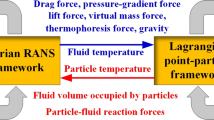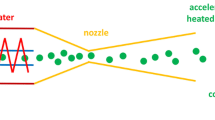Abstract
The two-phase flow properties of copper particle laden nitrogen are computationally modeled and compared with the data obtained from the experiments, determining the achievable degree of consistency between model and reality. Two common, commercial nozzles are studied. A two-way coupled Lagrangian scheme along with the RSM turbulence model is used to track the particles and to model the interactions between the gas and the particulate phase. Significant agreement is found for the geometrical gas flow structure, the resulting particle velocities, and the dependence of the two-phase flow on the particulate phase mass loading. The particle velocities decrease with increasing mass loading, even for modest powder feed rates of <3 g/s. The velocity drop occurs even when the gas flow rate is kept constant. Adiabatic gas flow models neglecting the energy consumption by the particles are thus inaccurate, except for very dilute suspensions with low technical relevance. For the cases modeled, the experiments evidence the high predictive power of the chosen CFD approach.














Similar content being viewed by others
Abbreviations
- A :
-
cross-sectional area of the particle, m2
- C D :
-
drag coefficient
- D :
-
particle diameter, m
- F b :
-
body force, N
- Ma :
-
Mach number
- m :
-
mass, kg
- R :
-
specific gas constant, J/kg K
- Re :
-
Reynolds number
- T :
-
temperature, K
- t :
-
time, s
- V :
-
velocity vector, m/s
- ρ:
-
density, kg/m3
- γ:
-
specific heat ratio
- μ:
-
molecular viscosity, kg/m s
- p:
-
particles
- g:
-
gas
References
A. Papyrin, V. Kosarev, S. Klinkov, A. Alkhimov, and V. Fomin, Cold Spray Technology, Elsevier, Amsterdam, 2006
V.K. Champagne, Ed., The Cold Spray Materials Deposition Process: Fundamentals and Applications, Woodhead, Cambridge, UK, 2007
M.J. Zucrow and J.D. Hoffman, Gas Dynamics. Volume 2: Multidimensional Flow, Wiley, New York, 1977
T. Stoltenhoff, Kaltgasspritzen von Kupfer, Shaker Verlag, Aachen, 2004
A. Schwenk, Entwicklung und Erprobung neuartiger Düsen für das atmosphärische Plasma-spritzen. Werkstoffe und werkstofftechnische Anwen-dungen, Vol 20. TU Chemnitz, 2005
M. Grujicic, W.S. DeRosset, and D. Helfritch, Flow Analysis and Nozzle-Shape Optimization for the Cold-gas Dynamic-Spray Process, J. Eng. Manuf., 2003, 217, p 1603-1613
B. Samareh and A. Dolatabadi, A Three-Dimensional Analysis of the Cold Spray Process: The Effects of Substrate Location and Shape, J. Therm. Spray Tech., 2007, 16(16), p 634-642
M. Karimi, A. Fartaj, G.W. Rankin, D. Vanderzwet, J. Villafuerte, and W. Birtch, Numerical Simulation of the Cold Gas Dynamic Spray Process, J. Therm. Spray Tech., 2006, 15(4), p 518-523
D.L. Gilmore, R.C. Dykhuizen, R.A. Neiser, T.J. Roemer, and M.F. Smith, J. Therm. Spray Tech., 1999, 8(4), p 576-582
T.H. Van Steenkiste, J.R. Smith, R.E. Teets, J.J. Moleski, D.W. Gorkiewicz, R.P. Tison, D.R. Marantz, K.A. Kowalsky, W.L. Riggs, P.H. Zajchowski, B. Pilsner, R.C. McCune, and K.J. Barnett, Kinetic Spray Coatings, Surf. Coat. Technol., 1999, 111(1), p 62-71
K. Taylor, B. Jodoin, and J. Karov, J. Therm. Spray Tech., 2006, 15(2), p 273-279
W. Li and C. Li, Optimization of Spray Conditions in Cold Spraying Based on Numerical Analysis of Particle Velocity, Trans. Nonferrous Metal. Soc. China, 2004, 14(Special 2), p 43-48
B. Jodoin, F. Raletz, and M. Vardelle, Cold Spray Flow Modeling and Validation, Proceedings of the 2005 International Thermal Spray Conference, 2005, Basel, Switzerland
Section 8.4: Viscosity, FLUENT 6.3 Documents, ANSYS Inc
B. Jodoin, Cold Spray Nozzle Mach Number Limitations, J. Therm. Spray Tech., 2002, 11(4), p 496-507
S. Sarkar, G. Erlebacher, M.Y. Hussaini, and H.O. Kreiss, Analysis and Modeling of Dilatation Term in Compressible Turbulence, J. Fluid Mech., 1991, 227, p 473-493
S. Sarkar and B. Lakshmanan, Application of a Reynolds Stress Turbulence Model to the Compressible Shear Layer, AIAA J., 1991, 29(5), p 743-749
C.T. Crowe, Drag Coefficient on Particles in a Rocket Nozzle, AIAA J., 1967, 5(5), p 1021-1022
R. Clift, J.R. Grace, and M.E. Weber, Bubbles, Drops and Particles, New York, Academic Press, 1978
A. Dolatabadi, J. Mostaghimi, and L. Pershin, Modeling Dense Suspension of Solid Particles in Highly Compressible Flows, J. Comput. Fluid Dynamics, 2004, 18(2), p 125-131
Acknowledgments
U. Pyritz, F. Heinrichsdorff, and V. Türck are gratefully acknowledged for their contributions to the measurements. A. Dolatabadi would like to thank Natural Sciences and Engineering Research Council of Canada (NSERC).
Author information
Authors and Affiliations
Corresponding author
Rights and permissions
About this article
Cite this article
Samareh, B., Stier, O., Lüthen, V. et al. Assessment of CFD Modeling via Flow Visualization in Cold Spray Process. J Therm Spray Tech 18, 934–943 (2009). https://doi.org/10.1007/s11666-009-9363-9
Received:
Revised:
Accepted:
Published:
Issue Date:
DOI: https://doi.org/10.1007/s11666-009-9363-9




